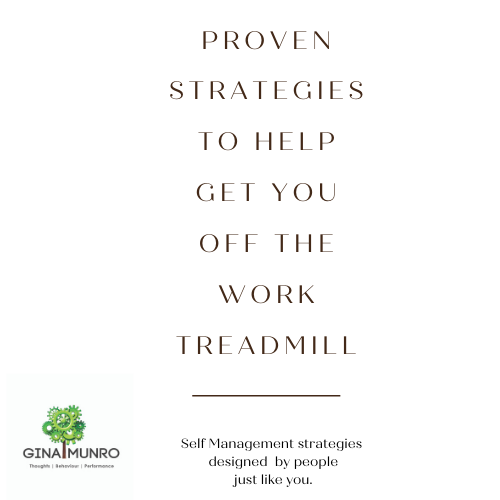What is critical thinking? When we hear the phrase ‘critical thinking’ we tend to assume…

Proven strategies to get you off the workplace treadmill
I’ve been working in the Overwhelm, Burnout, Wellbeing, SelfManagement space recently where people have found themselves on a workplace treadmill that is going faster and faster.
Here are some of the strategies they have found to be helpful.
Strategy 1: Pause and Breathe
I hear you laughing but hear me out. When you are running so fast, you are not always aware that you’re about to fall off the back of the treadmill. The pause and breathe provides you the space to acknowledge that you’re in a bit of trouble and something needs to change.
Strategy 2: Reality check
List absolutely everything that you need to get done in one 24 hrs. Do it for the week/month whatever works for you. Listing everything, including tasks and responsibilities outside of work, allows you a realistic view of what you are dealing with. Often people only list appointments for example while failing to look at the wider tasks required in the day. Then can’t get everything done because there was never going to be enough time they just hadn’t taken a realistic look.
Strategy 3: Add some Fat
Often people report that they have a plan for the day and then something or someone derails them. If you have absolutely every moment of your day accounted for and there is no fat for the unexpected then you have not been realistic with managing your time. Build in at least two 30 mins periods in each day that will allow you to catch up and get back on track. At the very least, this will provide you with the time to communicate clearly with others, and at worst it’s not needed in which case you can do strategy 1: pause and breathe.
Strategy 4: Set realistic expectations (of yourself and others)
Allocate time to complete a task realistically, allowing for unpredictables to occur. Communicate your realistic timeframes to others so they are clear on when you can do something, how long it will take, and what tasks you will be completing during that time.
Strategy 5: Hold your boundaries
Do not allow project/task creep. If you see the opportunity for creep treat it as a new task and repeat strategy 2-4. This often happens when working in the trades, the tradesperson gets on site and the clients say “while you are here, can you just do XYZ”. It makes sense, as you are already on site but agreeing to this has consequences that are compounding.
Strategy 5: Don’t steal from Peter to pay Paul
This phrase doesn’t seem to be used much anymore but it basically means don’t steal from one task to complete another. Often this happens when you have not met a previous commitment so you steal from an existing commitment in order to complete – simply passing the problem along.
Strategy 6: Communicate
Take the time to ensure that all stakeholders are up-to-date and you have communicated clearly.
Strategy 7: Review and Adjust
This process requires you to regularly perform all 6 strategies. These strategies work if you follow each one – many others before you, regardless of industry, have shown this to be true. If it’s not working for you then review (reality check) and adjust.
If you need some help with any of the above, feel free to contact me.



